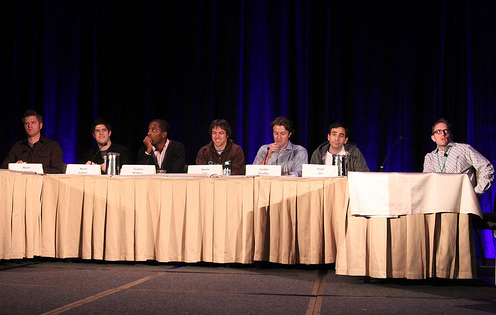 Today at the RealTime CrunchUp, representatives from some of the top companies involved in location based services came together to talk about the current state and future of geo-based services.
Today at the RealTime CrunchUp, representatives from some of the top companies involved in location based services came together to talk about the current state and future of geo-based services.
Participating in the panel were:
Matt Galligan, co-Founder of SimpleGeo
Ryan Sarver, Director of Platform at Twitter
Tristan Walker, VP of Business Development at Foursquare
Steve Lee, Group Product Manager Google Maps for Mobile and Google Latitude
Justin Shaffer, Founder of Hot Potato
Elad Gil, CEO of Mixer Labs
Moderators were our own Erick Schonfeld and MG Siegler.
http://www.ustream.tv/flash/video/2603549
Early in the panel, the conversation turned to SimpleGeo, the new infrastructure for location that was revealed earlier this week. Shaffer spoke about how excited he was about the new service. When asked if anyone could copy what Foursquare was doing, Walker talked about Foursquare’s efforts to filter content (which is harder to reproduce).
MG then steered the conversation toward bridging the gap between social networks and the real world, noting that mobile devices are paving the way for this change. But he wondered how services other than Foursquare (which has a game mechanic) would entice users to share their location on a regular basis.
Lee addressed concerns over Latitude’s continuous location sharing, explaining that you can share your location with certain people who you specify, but that Latitude’s approach to constant tracking leads to the ability to offer interesting services. He says that without continuous sharing nearby alerts wouldn’t be possible (or at least as effective). He says that the check-in model and the continuous model will likely coexist (and that check-in can even help give more context about where you are) but that there’s things you can’t do without continuous tracking. Regarding Checking in verus continuous mapping, Elad Gil says he’s seeing about a “nine to ten” relationship between them.
Galligan chimed in by saying that there will be a point when we know where everyone is, but that the context won’t necessarily be known. Galligan then revealed a new technology they are working on involving four dimensions of geolocation that SimpleGeo has created, which allows them to compress location and time stamps into a datapoint, allowing apps to look into the past for the same location.
Sarver talked about why Twitter was interested in location, describing how it would help filter through the noise. He mentioned TrendsMap.com as a great way to visualize geotagged tweets.
Shaffer said that HotPotato is looking to integrate location into their service, but that another key element is what brings conversation together. He says that just location data isn’t necessarily enough (he points out that people watching a baseball game may actually be at the game, or watching on TV.)
In terms of advertising, there seemed to be a broad consensus that geo-based advertising had the potential to be extremley successful. Galligan brought up the potential of special ads and deals, pointing to Yowza as a great example. Saffer later commented that there’s a fine line that these services have to work with — it would be a negative for ads to actually feel like ads (instead it would be better for them to feel like deals).